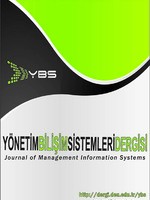SBM TOPLULUK TESPİTİNDE TEMEL GERÇEK VE ÜST VERİ İLİŞKİSİ: OKUL ARKADAŞLIK AĞI
Stokastik Blok Modelleme, Topluluk Tespiti, , Yakın Arkadaşlık Ağı
GROUND TRUTH AND METADATA RELATIONSHIP IN SBM COMMUNITY DETECTION: SCHOOL FRIENDSHIP NETWORK
Community Detection SBM, neoSBM, , Best Friends Network,
___
- Bui, T. N., & Jones, C. (1992). Finding good approximate vertex and edge partitions is NP-hard. Information Processing Letters, 42(3), 153-159
- Chen, H., Chiang, R. H., & Storey, V. C. (2012). Business intelligence and analytics: from big data to big impact. MIS quarterly, 1165-1188.
- Chau, M., & Xu, J. (2012). Business intelligence in blogs: Understanding consumer interactions and communities. MIS quarterly, 1189-1216.
- Fortunato, S., & Barthelemy, M. (2007). Resolution limit in community detection. Proceedings of the National Academy of Sciences, 104(1), 36-41.
- Golbeck, J., Gerhard, J., O’Colman, F., & O’Colman, R. (2017). Scaling Up Integrated Structural and Content-Based Network Analysis. Information Systems Frontiers, 1-12.
- Karrer, B., & Newman, M. E. (2011). Stochastic blockmodels and community structure in networks. Physical review E, 83(1), 016107.
- Miranda, S. M., Kim, I., & Summers, J. D. (2015). Jamming with Social Media: How Cognitive Structuring of Organizing Vision Facets Affects IT Innovation Diffusion. Mis Quarterly, 39(3).
- Newman, M. E. (2002). Assortative mixing in networks. Physical review letters, 89(20), 208701.
- Newman, M. E., & Girvan, M. (2004). Finding and evaluating community structure in networks. Physical review E, 69(2), 026113.
- Newman, M. E. (2006). Modularity and community structure in networks. Proceedings of the national academy of sciences, 103(23), 8577-8582.
- Peel, L., Larremore, D. B., & Clauset, A. (2017). The ground truth about metadata and community detection in networks. Science advances, 3(5), e1602548.
- Perdahci, Z. N., Aydin, M. N., & Kariniauskaitė, D. (2017). Dynamic Loyal Customer Behavior for Community Formation: A Network Science Perspective.
- Perdahcı, Z. N., Aydın, M. N., & Kafkas, K. (2019). SBM Based Community Detection: School Friendship Network.
- Zhang, K., Bhattacharyya, S., & Ram, S. (2016). Large-Scale Network Analysis for Online Social Brand Advertising. Mis Quarterly, 40(4).
- ISSN: 2630-550X
- Başlangıç: 2015
- Yayıncı: Vahap TECİM
YAPAY ZEKÂ İŞLETME YÖNETİMİ İLİŞKİSİ ÜZERİNE BİR DEĞERLENDİRME
SAĞLIK İŞLETMELERİNDE KURUMSAL MİMARİ BİLEŞENLERİ: BİR SİSTEMATİK HARİTALAMA ÇALIŞMASI
Gülten ŞENKUL, Murat Paşa UYSAL
SBM TOPLULUK TESPİTİNDE TEMEL GERÇEK VE ÜST VERİ İLİŞKİSİ: OKUL ARKADAŞLIK AĞI
Kenan KAFKAS, Nazım Ziya PERDAHÇI, Mehmet Nafiz AYDIN
MEDICAL SENTIMENT ANALYSIS BASED ON SOFT VOTING ENSEMBLE ALGORITHM
MARKA İMAJ TAKİBİ İÇİN SOSYAL MEDYA ANALİTİĞİ: TÜRK HAVA YOLLARI İÇİN BİR VAKA ÇALIŞMASI
DUYGU ANALİZİ İLE OTEL MÜŞTERİLERİNİN YILDIZ DEĞERLENDİRMELERİNİN TAHMİNİ
